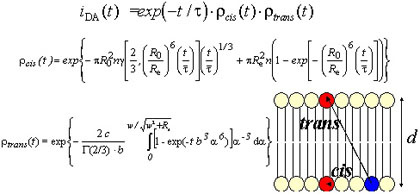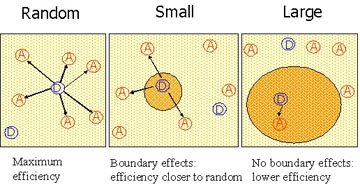 
Fluorescence Resonance Energy Transfer (FRET)
A particularly powerful fluorescence
technique to probe membrane organization and lipid-protein interaction
is fluorescence resonance energy transfer (FRET; Theodore Förster,
1949). The rate of energy transfer between a donor molecule, with
fluorescence lifetime τ, and an acceptor molecule,
separated by a distance R, is given by

where R0 is the critical
distance, which can be calculated from

where in turn κ2
is the orientation factor, ΦD is the donor
quantum yield in the absence of acceptor, n is the refractive
index, λ is the wavelength, I(λ) is
the normalized donor emission spectrum, and ε(λ)
is
the acceptor molar absorption spectrum. In the latter equation, if
the λ units used are nm, the calculated R0 has
Å units.
If each donor senses a single acceptor in its
vicinity, and the donor-acceptor distance is the same for all pairs,
then FRET is easily used as a "spectroscopic ruler" to measure
distances in the 1-10 nm range. In case the donor molecules are
surrounded by a distribution of acceptors, the decay law becomes
complex (Figure 1), and depends on the acceptor concentration and
distribution.

|
|
Figure 1 - Cartoon and Equations for
time-resolved FRET in bilayers, assuming both planar (cis) and
interplanar (trans) transfer.
|
Membrane phase separation leads to partition
of both donor and acceptor probes between the two phases. In general,
the donor fraction and fluorescence properties will be different in the
two phases, as will be the local acceptor concentrations. Analysis of
time-resolved donor fluorescence in presence and absence of acceptor
allows the recovery of all these parameters, and, from deviations to
the theoretical expectations, information about domain size can be
inferred (Figure 2).

|
|
Figure 2 - Schematic representation of
FRET in phase separated membranes, in a situation where donor and
acceptor partition preferably to different phases.
|
Regarding lipid-protein interaction, FRET is
helpful in quantification of lipid-protein selectivity, determining the
transverse location of the peptide/protein fluorophore, and probing the
peptide/protein aggregation state, among other other important
questions.
go back to Research Interests
|